MENU
The Electronic Scholarly Publishing Project: Providing access to classic scientific papers and other scholarly materials, since 1993. More About: ESP | OUR CONTENT | THIS WEBSITE | WHAT'S NEW | WHAT'S HOT
Comparative Timelines
The ESP Timeline (one of the site's most popular features) has been completely updated to allow the user to select (using the timeline controls above each column) different topics for the left and right sides of the display.
Select:
New Left Column
New Left Column
Dates
Decade
New Right Column
New Right Column
 R. A. Fisher publishes Genetical Theory of Natural Selection, a formal analysis of the mathematics of selection.
R. A. Fisher publishes Genetical Theory of Natural Selection, a formal analysis of the mathematics of selection.
1930
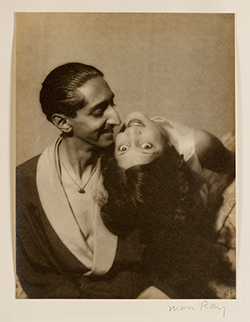 Photograph by Man Ray: Yeshwant Rao Holkar II and Sanyogita Devi of Indore. The Maharaja of Indore spent much time in Europe and the United States (one of his homes was in Santa Ana, California). He became a patron of many important artists and designers of his day. The Paris-based American avant-garde photographer Man Ray photographed Yeshwant Rao Holkar extensively. This informal and intimate image of the Maharaja and his wife were probably taken when they were on holiday in Cannes, in the south of France.
Photograph by Man Ray: Yeshwant Rao Holkar II and Sanyogita Devi of Indore. The Maharaja of Indore spent much time in Europe and the United States (one of his homes was in Santa Ana, California). He became a patron of many important artists and designers of his day. The Paris-based American avant-garde photographer Man Ray photographed Yeshwant Rao Holkar extensively. This informal and intimate image of the Maharaja and his wife were probably taken when they were on holiday in Cannes, in the south of France.
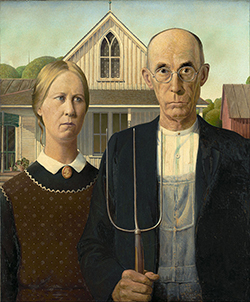 Painting by Grant Wood: American Gothic. Wood's inspiration came from what is now known as the American Gothic House, and his decision to paint the house along with "the kind of people I fancied should live in that house." Created in 1930, it depicts a farmer standing beside a woman that has been interpreted to be either his wife or his daughter. The figures were modeled by Wood's sister, Nan Wood Graham, and a local dentist, Dr. Byron McKeeby. The woman is dressed in a colonial print apron evoking 19th-century Americana, and the man is holding a pitchfork. It is one of the most familiar images in 20th-century American art, and has been widely parodied in American popular culture.
Painting by Grant Wood: American Gothic. Wood's inspiration came from what is now known as the American Gothic House, and his decision to paint the house along with "the kind of people I fancied should live in that house." Created in 1930, it depicts a farmer standing beside a woman that has been interpreted to be either his wife or his daughter. The figures were modeled by Wood's sister, Nan Wood Graham, and a local dentist, Dr. Byron McKeeby. The woman is dressed in a colonial print apron evoking 19th-century Americana, and the man is holding a pitchfork. It is one of the most familiar images in 20th-century American art, and has been widely parodied in American popular culture.
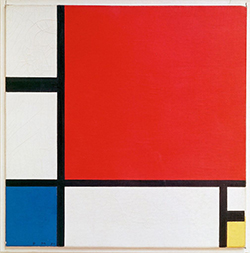 Painting by Piet Mondrian: Composition II in Red, Blue, and Yellow
Painting by Piet Mondrian: Composition II in Red, Blue, and Yellow
(no entry for this year)
1931
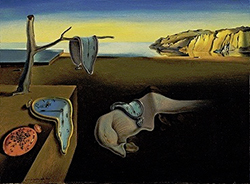 Painting by Salvador Dalí: The Persistence of Memory (Catalan: La persistència de la memòria) is one of his most recognizable works. First shown at the Julien Levy Gallery in 1932, since 1934 the painting has been in the collection of the Museum of Modern Art (MoMA) in New York City, which received it from an anonymous donor. The well-known surrealist piece introduced the image of the soft melting pocket watch. It epitomizes Dalí's theory of "softness" and "hardness", which was central to his thinking at the time. As Dawn Adès wrote, "The soft watches are an unconscious symbol of the relativity of space and time, a Surrealist meditation on the collapse of our notions of a fixed cosmic order". This interpretation suggests that Dalí was incorporating an understanding of the world introduced by Albert Einstein's theory of special relativity. Asked by Ilya Prigogine whether this was in fact the case, Dalí replied that the soft watches were not inspired by the theory of relativity, but by the surrealist perception of a Camembert melting in the sun.
Painting by Salvador Dalí: The Persistence of Memory (Catalan: La persistència de la memòria) is one of his most recognizable works. First shown at the Julien Levy Gallery in 1932, since 1934 the painting has been in the collection of the Museum of Modern Art (MoMA) in New York City, which received it from an anonymous donor. The well-known surrealist piece introduced the image of the soft melting pocket watch. It epitomizes Dalí's theory of "softness" and "hardness", which was central to his thinking at the time. As Dawn Adès wrote, "The soft watches are an unconscious symbol of the relativity of space and time, a Surrealist meditation on the collapse of our notions of a fixed cosmic order". This interpretation suggests that Dalí was incorporating an understanding of the world introduced by Albert Einstein's theory of special relativity. Asked by Ilya Prigogine whether this was in fact the case, Dalí replied that the soft watches were not inspired by the theory of relativity, but by the surrealist perception of a Camembert melting in the sun.
(no entry for this year)
1932
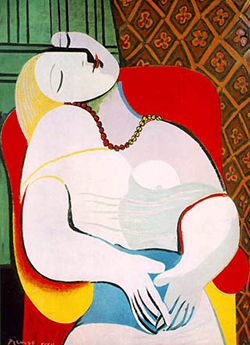 Painting by Pablo Picasso: Le Rêve (French, "The Dream") portrays his 22-year-old mistress Marie-Thérèse Walter. It is said to have been painted in one afternoon, on 24 January 1932. It belongs to Picasso's period of distorted depictions, with its oversimplified outlines and contrasted colors resembling early Fauvism. In 2001, casino magnate Steve Wynn purchased the work for an undisclosed sum, estimated to be about $60 million. In October 2006, Wynn told a group of his friends that he had agreed the day before to sell the painting for $139 million to Steven A. Cohen. At the time, this price would have made Le Rêve the most expensive piece of art ever. While Wynn was showing the painting to his friends, he put his right elbow through the canvas, puncturing the left forearm of the figure and creating a six-inch tear. After a $90,000 repair, the painting was re-valued at $85 million. Wynn filed a claim to recover the $54 million perceived loss from his Lloyd's of London insurers, an amount which would have covered most of the initial cost of buying the painting. When the insurers balked, Wynn sued them in January 2007. The case was eventually settled out of court in March 2007. Cohen bought the painting from Wynn in 2013 for $155 million. The price is estimated to be the highest ever paid, up to that time, for an artwork by a U.S. collector
Painting by Pablo Picasso: Le Rêve (French, "The Dream") portrays his 22-year-old mistress Marie-Thérèse Walter. It is said to have been painted in one afternoon, on 24 January 1932. It belongs to Picasso's period of distorted depictions, with its oversimplified outlines and contrasted colors resembling early Fauvism. In 2001, casino magnate Steve Wynn purchased the work for an undisclosed sum, estimated to be about $60 million. In October 2006, Wynn told a group of his friends that he had agreed the day before to sell the painting for $139 million to Steven A. Cohen. At the time, this price would have made Le Rêve the most expensive piece of art ever. While Wynn was showing the painting to his friends, he put his right elbow through the canvas, puncturing the left forearm of the figure and creating a six-inch tear. After a $90,000 repair, the painting was re-valued at $85 million. Wynn filed a claim to recover the $54 million perceived loss from his Lloyd's of London insurers, an amount which would have covered most of the initial cost of buying the painting. When the insurers balked, Wynn sued them in January 2007. The case was eventually settled out of court in March 2007. Cohen bought the painting from Wynn in 2013 for $155 million. The price is estimated to be the highest ever paid, up to that time, for an artwork by a U.S. collector
Robert Broom publishes The Coming of Man: Was it Accident or Design? arguing that evolution is really driven by spiritual agencies, some with conflicting priorities, and that mankind is the ultimate aim of all evolution.
1933
(no entry for this year)
(no entry for this year)
1934
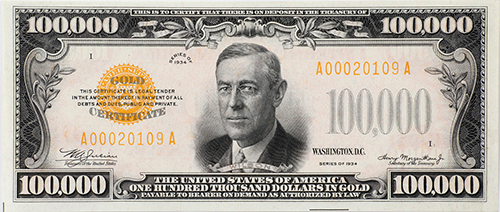 Currency as Art: The United States one-hundred-thousand-dollar bill (US$100,000), created during the Great Depression in response to the hoarding of gold. The bill, which features President Woodrow Wilson, was created as a large denomination note for gold transactions between Federal Reserve Banks; it never circulated publicly and its private possession is illegal. About 42,000 of the $100,000 bills were printed. Many were destroyed in the years following their commission, with the remaining few in possession of the United States federal government. The $100,000 bill, in possession aside from the federal government, is deemed illegal on account of its large denomination and the regulations declared at its signing.
Currency as Art: The United States one-hundred-thousand-dollar bill (US$100,000), created during the Great Depression in response to the hoarding of gold. The bill, which features President Woodrow Wilson, was created as a large denomination note for gold transactions between Federal Reserve Banks; it never circulated publicly and its private possession is illegal. About 42,000 of the $100,000 bills were printed. Many were destroyed in the years following their commission, with the remaining few in possession of the United States federal government. The $100,000 bill, in possession aside from the federal government, is deemed illegal on account of its large denomination and the regulations declared at its signing.
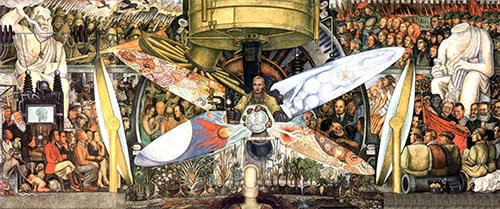 Fresco by Diego Rivera: Man at the Crossroads was intended for New York City's Rockefeller Center. The painting was controversial because it included an image of Lenin and a Soviet Russian May Day parade. Despite protests from artists, Nelson Rockefeller ordered its destruction before it was completed. Only black-and-white photographs exist of the original incomplete mural, taken when Rivera was forced to stop work on it. Using the photographs, Rivera repainted the composition in Mexico under the variant title Man, Controller of the Universe. The creation and destruction of the mural is dramatized in the films Cradle Will Rock (1999) and Frida (2002).
Fresco by Diego Rivera: Man at the Crossroads was intended for New York City's Rockefeller Center. The painting was controversial because it included an image of Lenin and a Soviet Russian May Day parade. Despite protests from artists, Nelson Rockefeller ordered its destruction before it was completed. Only black-and-white photographs exist of the original incomplete mural, taken when Rivera was forced to stop work on it. Using the photographs, Rivera repainted the composition in Mexico under the variant title Man, Controller of the Universe. The creation and destruction of the mural is dramatized in the films Cradle Will Rock (1999) and Frida (2002).
(no entry for this year)
1935
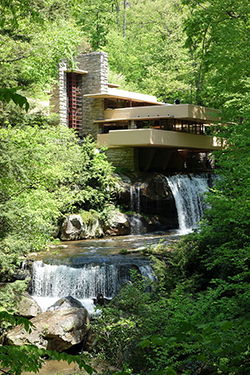 Architecture by Frank Lloyd Wright: Fallingwater or the Kaufmann Residence is a house in rural southwestern Pennsylvania, 43 miles southeast of Pittsburgh. The home was built partly over a waterfall on Bear Run in the Mill Run section of Stewart Township, Fayette County, Pennsylvania, in the Laurel Highlands of the Allegheny Mountains. The house was designed as a weekend home for the family of Liliane Kaufmann and her husband, Edgar J. Kaufmann, owner of Kaufmann's department store. Time cited it after its completion as Wright's "most beautiful job"; it is listed among Smithsonian's Life List of 28 places "to visit before you die". It was designated a National Historic Landmark in 1966. In 1991, members of the American Institute of Architects named the house the "best all-time work of American architecture" and in 2007, it was ranked 29th on the list of America's Favorite Architecture according to the AIA.
Architecture by Frank Lloyd Wright: Fallingwater or the Kaufmann Residence is a house in rural southwestern Pennsylvania, 43 miles southeast of Pittsburgh. The home was built partly over a waterfall on Bear Run in the Mill Run section of Stewart Township, Fayette County, Pennsylvania, in the Laurel Highlands of the Allegheny Mountains. The house was designed as a weekend home for the family of Liliane Kaufmann and her husband, Edgar J. Kaufmann, owner of Kaufmann's department store. Time cited it after its completion as Wright's "most beautiful job"; it is listed among Smithsonian's Life List of 28 places "to visit before you die". It was designated a National Historic Landmark in 1966. In 1991, members of the American Institute of Architects named the house the "best all-time work of American architecture" and in 2007, it was ranked 29th on the list of America's Favorite Architecture according to the AIA.
(no entry for this year)
1936
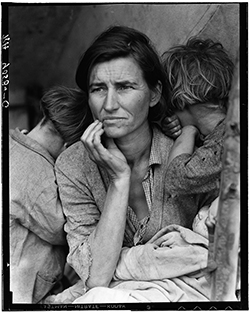 Photograph by Dorothea Lange: Migrant Mother is one of a series of photographs that Lange made of Florence Owens Thompson and her children in February or March of 1936 in Nipomo, California. Lange was concluding a month's trip photographing migratory farm labor around the state for what was then the Resettlement Administration. The images were made using a Graflex camera. The original negatives are 4x5" film. In 1960, Lange gave this account of the experience: I saw and approached the hungry and desperate mother, as if drawn by a magnet. I do not remember how I explained my presence or my camera to her, but I do remember she asked me no questions. I made five exposures, working closer and closer from the same direction. I did not ask her name or her history. She told me her age, that she was thirty-two. She said that they had been living on frozen vegetables from the surrounding fields, and birds that the children killed. She had just sold the tires from her car to buy food. There she sat in that lean- to tent with her children huddled around her, and seemed to know that my pictures might help her, and so she helped me. There was a sort of equality about it.
Photograph by Dorothea Lange: Migrant Mother is one of a series of photographs that Lange made of Florence Owens Thompson and her children in February or March of 1936 in Nipomo, California. Lange was concluding a month's trip photographing migratory farm labor around the state for what was then the Resettlement Administration. The images were made using a Graflex camera. The original negatives are 4x5" film. In 1960, Lange gave this account of the experience: I saw and approached the hungry and desperate mother, as if drawn by a magnet. I do not remember how I explained my presence or my camera to her, but I do remember she asked me no questions. I made five exposures, working closer and closer from the same direction. I did not ask her name or her history. She told me her age, that she was thirty-two. She said that they had been living on frozen vegetables from the surrounding fields, and birds that the children killed. She had just sold the tires from her car to buy food. There she sat in that lean- to tent with her children huddled around her, and seemed to know that my pictures might help her, and so she helped me. There was a sort of equality about it.
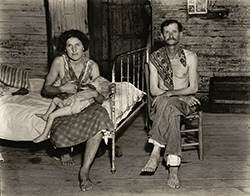 Photograph by Walker Evans: Bud Fields with His Wife Ivy, and His Daughter Ellen, Hale County, Alabama, now in the J. Paul Getty Museum.
Photograph by Walker Evans: Bud Fields with His Wife Ivy, and His Daughter Ellen, Hale County, Alabama, now in the J. Paul Getty Museum.
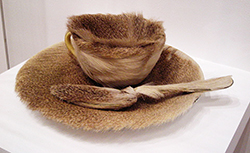 Sculpture by Méret Oppenheim: Object (Le Déjeuner en fourrure) [Object (Breakfast in Fur)]. The sculpture consists of a teacup, saucer and spoon that the artist covered with fur from a Chinese gazelle. The fur suggests an expensively decked-out woman; the cup, hollow yet round, can evoke female genitalia; the spoon with its phallic shape further eroticizes the hairy object. It was purchased by Alfred Barr for the collection of the Museum of Modern Art in New York and included the museum's first surrealist exhibition Fantastic Art: Dada and Surrealism in 1936. Oppenheim was willing to sell the piece for one thousand francs, but Barr only offered her $50 and she accepted. This was the first piece of art that the museum acquired, and Oppenheim became known as the First Lady of MoMA. The enormous success of this early work would later create problems for Oppenheim as an artist. Soon after its creation she drifted away from the Surrealists. Decades later, in 1972, she artistically commented on its dominance of her career by producing a number of "souvenirs" of Le Déjeuner en fourrure.
Sculpture by Méret Oppenheim: Object (Le Déjeuner en fourrure) [Object (Breakfast in Fur)]. The sculpture consists of a teacup, saucer and spoon that the artist covered with fur from a Chinese gazelle. The fur suggests an expensively decked-out woman; the cup, hollow yet round, can evoke female genitalia; the spoon with its phallic shape further eroticizes the hairy object. It was purchased by Alfred Barr for the collection of the Museum of Modern Art in New York and included the museum's first surrealist exhibition Fantastic Art: Dada and Surrealism in 1936. Oppenheim was willing to sell the piece for one thousand francs, but Barr only offered her $50 and she accepted. This was the first piece of art that the museum acquired, and Oppenheim became known as the First Lady of MoMA. The enormous success of this early work would later create problems for Oppenheim as an artist. Soon after its creation she drifted away from the Surrealists. Decades later, in 1972, she artistically commented on its dominance of her career by producing a number of "souvenirs" of Le Déjeuner en fourrure.
T. Dobzhansky publishes Genetics and the Origin of Species — a milestone in evolutionary genetics.
1937
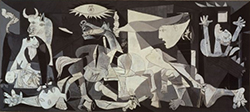 Painting by Pablo Picasso: Guernica is a mural-sized work that Picasso completed in June 1937, at his home on Rue des Grands Augustins, in Paris. The painting, which uses a palette of gray, black, and white, is regarded by many art critics as one of the most moving and powerful anti-war paintings in history. Standing at 3.49 meters (11 ft 5 in) tall and 7.76 meters (25 ft 6 in) wide, the large mural shows the suffering of people wrenched by violence and chaos. Prominent in the composition are a gored horse, a bull, and flames. The painting was created in response to the bombing of Guernica, a Basque Country village in northern Spain, by Nazi German and Fascist Italian warplanes at the request of the Spanish Nationalists. Upon completion, Guernica was exhibited at the Spanish display at the Exposition Internationale des Arts et Techniques dans la Vie Moderne (Paris International Exposition) in the 1937 World's Fair in Paris and then at other venues around the world. The touring exhibition was used to raise funds for Spanish war relief. The painting became famous and widely acclaimed, and it helped bring worldwide attention to the Spanish Civil War.
Painting by Pablo Picasso: Guernica is a mural-sized work that Picasso completed in June 1937, at his home on Rue des Grands Augustins, in Paris. The painting, which uses a palette of gray, black, and white, is regarded by many art critics as one of the most moving and powerful anti-war paintings in history. Standing at 3.49 meters (11 ft 5 in) tall and 7.76 meters (25 ft 6 in) wide, the large mural shows the suffering of people wrenched by violence and chaos. Prominent in the composition are a gored horse, a bull, and flames. The painting was created in response to the bombing of Guernica, a Basque Country village in northern Spain, by Nazi German and Fascist Italian warplanes at the request of the Spanish Nationalists. Upon completion, Guernica was exhibited at the Spanish display at the Exposition Internationale des Arts et Techniques dans la Vie Moderne (Paris International Exposition) in the 1937 World's Fair in Paris and then at other venues around the world. The touring exhibition was used to raise funds for Spanish war relief. The painting became famous and widely acclaimed, and it helped bring worldwide attention to the Spanish Civil War.
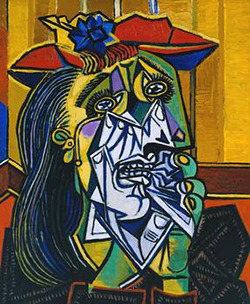 Painting by Pablo Picasso: The Weeping Woman. Picasso was intrigued with the subject, and revisited the theme numerous times that year. This painting was the final and most elaborate of the series. It has been in the collection of the Tate in London since 1987, and is on exhibition at the Tate Modern, London. Dora Maar was Picasso's mistress from 1936 until 1944. In the course of their relationship, Picasso painted her in a number of guises, some realistic, some benign, others tortured or threatening. Picasso explained: For me she's the weeping woman. For years I've painted her in tortured forms, not through sadism, and not with pleasure, either; just obeying a vision that forced itself on me. It was the deep reality, not the superficial one.
Painting by Pablo Picasso: The Weeping Woman. Picasso was intrigued with the subject, and revisited the theme numerous times that year. This painting was the final and most elaborate of the series. It has been in the collection of the Tate in London since 1987, and is on exhibition at the Tate Modern, London. Dora Maar was Picasso's mistress from 1936 until 1944. In the course of their relationship, Picasso painted her in a number of guises, some realistic, some benign, others tortured or threatening. Picasso explained: For me she's the weeping woman. For years I've painted her in tortured forms, not through sadism, and not with pleasure, either; just obeying a vision that forced itself on me. It was the deep reality, not the superficial one.
(no entry for this year)
1938
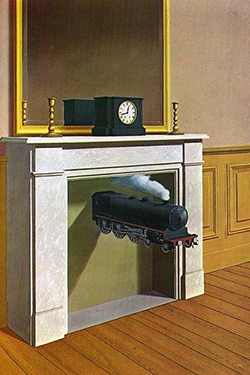 Painting by René Magritte: Time Transfixed (La Durée poignardée) is part of the permanent collection of the Art Institute of Chicago and is usually on display in the museum's new Modern Wing. The painting was one of many done for surrealist patron and Magritte supporter Edward James. The painting depicts a locomotive jutting out of a fireplace, at full steam, in an empty room. Above the mantelpiece is a tall mirror. Only the clock and one candlestick standing on the mantelpiece are reflected in the mirror. The title of the painting translates to English literally as "Ongoing Time Stabbed by a Dagger" and Magritte was reportedly unhappy with the generally accepted translation of "Time Transfixed".
Painting by René Magritte: Time Transfixed (La Durée poignardée) is part of the permanent collection of the Art Institute of Chicago and is usually on display in the museum's new Modern Wing. The painting was one of many done for surrealist patron and Magritte supporter Edward James. The painting depicts a locomotive jutting out of a fireplace, at full steam, in an empty room. Above the mantelpiece is a tall mirror. Only the clock and one candlestick standing on the mantelpiece are reflected in the mirror. The title of the painting translates to English literally as "Ongoing Time Stabbed by a Dagger" and Magritte was reportedly unhappy with the generally accepted translation of "Time Transfixed".
(no entry for this year)
1939
(no entry for this year)
ESP Quick Facts
ESP Origins
In the early 1990's, Robert Robbins was a faculty member at Johns Hopkins, where he directed the informatics core of GDB — the human gene-mapping database of the international human genome project. To share papers with colleagues around the world, he set up a small paper-sharing section on his personal web page. This small project evolved into The Electronic Scholarly Publishing Project.
ESP Support
In 1995, Robbins became the VP/IT of the Fred Hutchinson Cancer Research Center in Seattle, WA. Soon after arriving in Seattle, Robbins secured funding, through the ELSI component of the US Human Genome Project, to create the original ESP.ORG web site, with the formal goal of providing free, world-wide access to the literature of classical genetics.
ESP Rationale
Although the methods of molecular biology can seem almost magical to the uninitiated, the original techniques of classical genetics are readily appreciated by one and all: cross individuals that differ in some inherited trait, collect all of the progeny, score their attributes, and propose mechanisms to explain the patterns of inheritance observed.
ESP Goal
In reading the early works of classical genetics, one is drawn, almost inexorably, into ever more complex models, until molecular explanations begin to seem both necessary and natural. At that point, the tools for understanding genome research are at hand. Assisting readers reach this point was the original goal of The Electronic Scholarly Publishing Project.
ESP Usage
Usage of the site grew rapidly and has remained high. Faculty began to use the site for their assigned readings. Other on-line publishers, ranging from The New York Times to Nature referenced ESP materials in their own publications. Nobel laureates (e.g., Joshua Lederberg) regularly used the site and even wrote to suggest changes and improvements.
ESP Content
When the site began, no journals were making their early content available in digital format. As a result, ESP was obliged to digitize classic literature before it could be made available. For many important papers — such as Mendel's original paper or the first genetic map — ESP had to produce entirely new typeset versions of the works, if they were to be available in a high-quality format.
ESP Help
Early support from the DOE component of the Human Genome Project was critically important for getting the ESP project on a firm foundation. Since that funding ended (nearly 20 years ago), the project has been operated as a purely volunteer effort. Anyone wishing to assist in these efforts should send an email to Robbins.
ESP Plans
With the development of methods for adding typeset side notes to PDF files, the ESP project now plans to add annotated versions of some classical papers to its holdings. We also plan to add new reference and pedagogical material. We have already started providing regularly updated, comprehensive bibliographies to the ESP.ORG site.
ESP Picks from Around the Web (updated 06 MAR 2017 )
Old Science

Weird Science

Treating Disease with Fecal Transplantation
Fossils of miniature humans (hobbits) discovered in Indonesia

Dinosaur tail, complete with feathers, found preserved in amber.
Astronomy

Mysterious fast radio burst (FRB) detected in the distant universe.